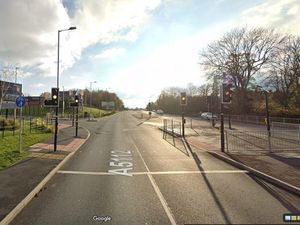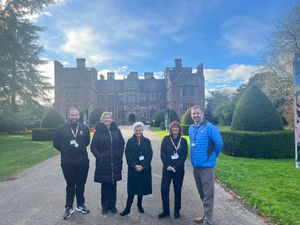'It just needs to evoke some kind of spark' – artist's touching sculptures feature in Shrewsbury trail
The Shrewsbury Arts Trail presents ‘Memento Mori’ by Halima Cassell this year – the striking pair of solid cast iron sculptures stand in front of Shrewsbury Castle walls, sandwiched between a Second World War field gun and the D-Day commemoration flower bed.
It’s a fitting setting for Cassell’s tear-drop shaped pieces, which deal with the deaths of her two best female friends.
The sculptures are part of Shrewsbury’s wider Sculpture Trail, celebrating all-British female sculptors this summer.
The tall, flame-like pieces, lit by sunlight, burn as brightly as the spirits of the powerful women they represent.
Halima says they are as much about life, reincarnation and the energy drawn from the universe.
“In one year, I lost two really strong women in my life,” says Cassell, who is one of the most dynamic sculptural ceramicists in the UK.
She was awarded an MBE in 2022 for services to the arts and recently won the 2024 Brookfield Properties Craft Award.
Her work is collected by prestigious collections worldwide including, most recently, Victoria and Albert Museum in London and the Hepworth Gallery.
She said: “In my life, from a young age, I didn’t have parents, so my friends are even closer. Friendship for me has always been a great thing. Making these pieces was a way of celebrating them both.
“Memento Mori is not just a fancy phrase. It’s a gentle nudge, a reminder that life’s embrace includes both joy and sorrow.
"It’s about acknowledging the beauty in our impermanence and honouring the memories of those who’ve walked this path before us.
"The story of Memento Mori is deeply personal. It emerged during a year of profound loss as I said goodbye to two dear friends. Their presence in my life was a gift, shaping me into who I am today.”
Kate-Anne Douglas was Cassell’s clubbing partner from her youth – a talented show jumper from Clitheroe in Lancashire, who lost her battle with cancer after eight years in February 2018, just after her 40th birthday.
She was first diagnosed with breast cancer in October 2010, two weeks after giving birth to her daughter Lola.
“She was from a well-to-do farming family and won lots of awards for her showjumping and worked at a very high level in a corporate job with only men in the office, but she never looked down on me being an artist and for not having money" – Cassell was born in Pakistan in 1975 and grew up in UK care homes.
"We always had so much fun together. No matter how late we had been out, she would always commit to what she’d committed to the following day. It was her who forced me to get out on New Year’s Eve when I met Martyn – after a year of solidly concentrating on my art practice and not going out partying. She was so happy for me. We had kids two weeks apart in our 30s.”
Halima’s second piece is in memory of ceramic tile artist Maggie Angus Berkowitz, an honorary member of the Craft Potters’ Association, who died aged 91.
She created colourful paintings on industrial tiles – in situ in bathrooms, kitchens and gardens.
Her public works included a swimming pool in Appleby and a town mural in Kendal.
Chris Blanchett devotes a whole chapter to her in his 20th Century Decorative British Tiles.
Maggie married American Marvin Berkowitz and lived and worked in Uganda and then New York for a while, but returned to the UK in 1970 following their divorce – a single mum with four children in tow.
“There are some people in your life you just admire,” Halima says. “They were both exceptionally hard workers and neither of them ever complained; neither of them had a sense of importance, they were both really humble.
“Maggie was an artist in the 1960s and 70s when women were struggling to gain recognition in the art world. Her understanding of her practice (glazing) at a scientific level was second to none. She was a single parent, who was amazingly talented, both academically and creatively. She spoke four languages (English, Swahili, Italian and Japanese); however, she changed her Lancastrian accent to fit in with the then upper-class art world.
“She was a great advocate for artists and an amazing teacher. On her 90th birthday, a few hundred people came to her party to praise and thank her. She lived by herself after the children had grown up and left and often had friends and colleagues in need as well as young students staying with her.
“She was a force to be reckoned with. When she first met me, she criticised my work quite harshly but I still fell in love. She was a devout catholic and strongly spoke her mind and believed religion was very important but she never judged others. It didn’t matter to her that Martyn and I were spiritually minded, rather than practising a religion. My kids absolutely adored her; she was a magnet to children and animals. She was always the first person on the dance floor and the last one to leave.
“On the day she died, she’d walked up a high hill, collected fresh watercress, had a hot pot on the Aga (dinner for her daughter), half a bottle of wine open and her stuff packed to come to mine to do some artwork.
“Both women lived life to the full. They have left a big impact on people’s lives. I hope when my sons grow up, they will meet strong women like Kate-Anne and Maggie who know what they are all about.
“These incredible women weren’t just friends; they were mentors, guiding lights in a sometimes murky world. Their stories of resilience and adventure remind me that life is meant to be lived fully, embracing every twist and turn along the way.”
Friendship fuels Halima’s creations – she’ll often work late into the night talking to friends on the phone as she sculpts: “What I do is so meditative, I get into the zone and before I know it, the birds are singing.
“People ask ‘do you need to work that hard?’ I say I love what I do and if I have a piece in my mind, I want it to exist. I’ll put the music on loud, have a glass of wine, ring my friends – work, talking, drinking. Whatever I do, I need it to be part of my working process and to love it.”
Halima is currently working on several private commissions and a commission for a gallery.
She also has a second piece on show during the Shrewsbury Arts Trail – ‘Hurricane’ – a beautiful, white sculpture in fibreglass and jesmonite, which stands over two metres tall in front of the spectacular stained glass Jesse window in St Mary’s Church.
It was first exhibited as part of her first solo exhibition at Glyndebourne in 2021 and echoes the raw power and unpredictable nature of its namesake, channelling the essence of natural phenomena – wind, rain and crashing waves – into a tangible expression of human experience.
“In crafting ‘Hurricane’ I sought to encapsulate a profound dialogue between form, light, and the natural world, weaving together elements of raw energy and fluidity,” Halima says. “Through my process of carving and shaping, I aimed to capture the essence of wind, rain, and crashing waves, infusing the sculpture with a sense of urgency and creative fervour.
“Making art that people interact with is what my job is. I want people to question it, to be curious about it, to want to touch it. Like a piece of architecture, it doesn’t have to say anything, it just needs to evoke some kind of spark. Bringing people together to engage and talk about art – that’s the main thing.”




